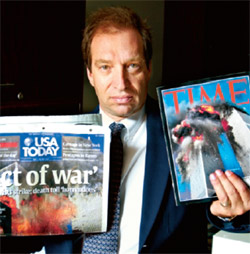Researchers Use Economic Tools in Analyzing Terrorism
by Lauren Bocchino

Although there was earlier much dispute over whether, when and how President Bush knew about the September 11 attacks on America, Dr. Walter Enders, professor of economics and Lee Bidgood Chair of Economics and Finance in the Culverhouse College of Commerce and Business Administration, had his own theories well more than a year prior to that fateful day.
In a paper published in August 2000, he and a co-author, Todd Sandler, predicted that cyclical patterns suggested that major terrorist activity was due again.
The suggestion was based on economic variables the two researchers had studied. Since 1989, Enders has applied his expertise in Time-Series Econometrics to estimate and forecast various economic variables, including the occurrence of transnational terrorist incidents.
He said the basic methodology uses standard economic theory to analyze terrorist behavior. “Todd Sandler and I believed that terrorist groups would act in a predictable way. Transnational terrorist groups attempt to economize on their scarce resources in a manner similar to that of everyday business firms. If the costs of performing one type of terrorist attack increase, rational terrorists will substitute into other similar types of attacks.”
After receiving a grant from the National Science Foundation to examine a data set consisting of transnational terrorist events, Enders, and Sandler of the University of South California, discovered several startling effects of the attempts to thwart terrorism.
One of the first discoveries came while analyzing a 1978 terrorism study by William Landes. In his study, Landes found that when metal detectors were installed at American airports in 1973, there were far fewer hijackings of planes over the next three years. However, when Enders used his skills as an applied econometrician he was able to discern a 1-1 substitution into other types of logistically complex events such as kidnappings and hostage takings. The installation of the metal detectors did not change the number of terrorist incidents, only the number of hijackings.
The data the researchers use is called International Terrorism: Attributes of Terrorist Events, or ITERATE. For each transnational terrorist incident, ITERATE records the date, location, type, number of people killed, the number of people wounded and other important variables. ITERATE in turn relies on the world’s print and electronic media for its data, with a particular reliance on the Foreign Broadcast Information Service’s Daily Reports, which surveys hundreds of the world’s newspapers and related sources.
Enders and Sandler documented that the number of terrorist incidents directed at the U.S. began to decline shortly after the collapse of the Soviet Union. They found reduced statesponsorship of terrorism and reduced interest in Marxist ideology contributed to the decline. However, as religious fundamentalism increased, the typical terrorist incident has become far more deadly. Their analysis showed that more than half of all transnational terrorist events involve bombs.
“The U.S. Presidential Commission on Terrorism discusses our findings that terrorists have substituted away from the use of small bombs and other incendiary devices into larger, more deadly, types of bombs,” Enders said.
Enders’ and Sandler’s research showed that enhanced fortification reduced attacks on U.S. embassies but led to an increase in the number of assassinations of U.S. protected persons. As embassy attacks became more difficult, terrorists conducted their attacks on U.S. embassy personnel outside the embassy grounds.
Sophisticated Time-Series methods have been developed to analyze fluctuations in economic variables such as Gross Domestic Product and unemployment. Enders and Sandler analyze terrorism using the same tools that economists use to analyze the business cycle. Cycles in terrorism are attributable to “copycat” effects (such as the anthrax attacks), the attack/counter-attack process, and economies of scale in planning and executing attacks.
Throughout their research, the two professors have shown that periods of high terrorism are not sustainable because terrorists expend their resources. During low-terrorism periods, terrorist groups acquire and replenish their resources, including weapons, funds and new recruits.
“Our work shows that defensive policies do little to thwart terrorism,” Enders said. “Terrorists look for the weakest link, and it is too difficult for a democratic society to effectively defend itself against all possible types of attacks. When there is too much attention paid to one kind of vulnerability, a weakness in security can be exploited elsewhere. Instead, the most successful policies have been those that reduce the ability of terrorists to acquire resources (including weapons, funds and personnel). Actions to freeze terrorist assets and reduce terrorist numbers are better at curbing terrorism than concentrating on select kinds of events or targets. By going after terrorist resources, the authorities thwart all forms of attacks; by focusing on a specific event, the authorities encourage a substitution among modes of attacks.”